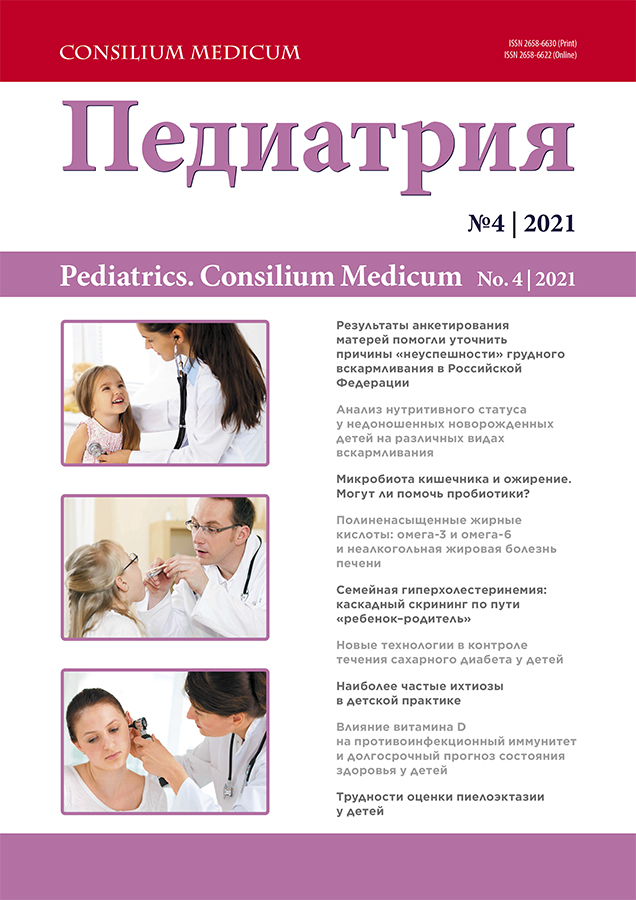The most frequent ichthyosis in children's practice: how we can help the patient
- Authors: Melnichenko O.O.1, Krasnikova V.N.1, Smolkina O.Y.2,3, Korsunskaya I.M.1,2
-
Affiliations:
- Moscow Scientific and Practical Center of Dermatology, Venereology and Cosmetology
- Center for Theoretical Problems of Physicochemical Pharmacology
- Scientific and Clinical Advisory Center for Allergology and Immunology
- Issue: No 4 (2021)
- Pages: 357-360
- Section: Articles
- URL: https://pediatria.orscience.ru/2658-6630/article/view/100645
- DOI: https://doi.org/10.26442/26586630.2021.4.201336
- ID: 100645
Cite item
Full Text
Abstract
The most common ichthyoses are vulgar and X-linked ichthyosis. Common in the pathogenesis of both types is a violation of the barrier function of the skin and increased transepidermal moisture loss. The clinical manifestations of these types of disease have some differences. As for the prevalence of ichthyosis, in recent years in Moscow there has been an increase in the incidence of both in the general population and in children. It is worth noting that ichthyosis has a very significant negative impact on the quality of life, especially in childhood. However, rational choice of therapy and means of care can improve the lives of our patients. The treatment regimen should include products with a long-lasting effect of increasing skin hydration. It is also necessary to pay attention to the choice of bathing products, avoid formulations containing potential allergens, which is especially important in cases where ichthyosis is combined with atopic dermatitis.
Full Text
About the authors
Olga O. Melnichenko
Moscow Scientific and Practical Center of Dermatology, Venereology and Cosmetology
Email: marykor@bk.ru
ORCID iD: 0000-0002-0522-3225
Cand. Sci. (Med.)
Russian Federation, MoscowVera N. Krasnikova
Moscow Scientific and Practical Center of Dermatology, Venereology and Cosmetology
Email: marykor@bk.ru
pediatric dermatologist
Russian Federation, MoscowOlga Yu. Smolkina
Center for Theoretical Problems of Physicochemical Pharmacology; Scientific and Clinical Advisory Center for Allergology and Immunology
Email: marykor@bk.ru
Res. Assist.
Russian Federation, MoscowIrina M. Korsunskaya
Moscow Scientific and Practical Center of Dermatology, Venereology and Cosmetology; Center for Theoretical Problems of Physicochemical Pharmacology
Author for correspondence.
Email: marykor@bk.ru
ORCID iD: 0000-0002-6583-0318
D. Sci. (Med.), Prof.
Russian Federation, MoscowReferences
- Dorf IL, Sommerlund M, Koppelhus U. Ichthyosis vulgaris. Ugeskr Laeger. 2020;182(17):V10190611 (in Danish). PMID: 32400366
- Oji V, Tadini G, Akiyama M, et al. Revised nomenclature and classification of inherited ichthyoses: results of the First Ichthyosis Consensus Conference in Sorèze 2009. J Am Acad Dermatol. 2010;63(4):607-41.
- Irvine AD, McLean WH, Leung DY. Filaggrin mutations associated with skin and allergic diseases. N Engl J Med. 2011;365(14):1315-27. doi: 10.1056/NEJMra1011040
- McLean WH. Filaggrin failure – from ichthyosis vulgaris to atopic eczema and beyond. Br J Dermatol. 2016;175 Suppl. 2(Suppl. Suppl. 2):4-7. doi: 10.1111/bjd.14997
- Crane JS, Paller AS. Ichthyosis X-Linked. 2020. In: StatPearls [Internet]. Treasure Island (FL): StatPearls Publishing, 2020. PMID: 28846233
- Diociaiuti A, Angioni A, Pisaneschi E, et al. X-linked ichthyosis: Clinical and molecular findings in 35 Italian patients. Exp Dermatol. 2019;28(10):1156-63. doi: 10.1111/exd.13667
- Traupe H, Fischer J, Oji V. Nonsyndromic types of ichthyoses – an update. J Dtsch Dermatol Ges. 2014;12(2):109-21. doi: 10.1111/ddg.12229
- Elias PM, Williams ML, Choi EH, et al. Role of cholesterol sulfate in epidermal structure and function: lessons from X‐linked ichthyosis. Biochim Biophys Acta. 2014;1841:353‐61.
- Hazan C, Orlow SJ, Schaffer JV. X‐linked recessive ichthyosis. Dermatol Online J. 2005;11:12.
- Корсунская И.М., Жукова О.В., Новожилова О.Л., Мельниченко О.О. К вопросу об эпидемиологии врожденного ихтиоза в Москве. Медицинский алфавит. 2021;18:59-62 [Korsunskaia IM, Zhukova OV, Novozhilova OL, Mel'nichenko OO. On epidemiology of congenital ichthyosis in Moscow. Meditsinskii alfavit. 2021;18:59-62 (in Russian)]. doi: 10.33667/2078-5631-2021-18-59-62
- Troiano G, Lazzeri G. A review of quality of life of patients suffering from ichthyosis. J Prev Med Hyg. 2020;61(3):E374-8. doi: 10.15167/2421-4248/jpmh2020.61.3.1450
- Ganemo A, Lindholm C, Lindberg M, et al. Quality of life in adults with congenital ichthyosis. J Adv Nurs. 2003;44:412-9. doi: 10.1046/j.0309-2402.2003.02820.x
- Ganemo A. Quality of life in Swedish children with congenital ichthyosis. Dermatol Reports. 2010;2:e7. doi: 10.4081/dr.2010.e7 10.4081/dr.2010.e7
- Sandilands A, Sutherland C, Irvine AD, McLean WHI. Filaggrin in thefrontline: role in skin barrier function and disease. J Cell Sci. 2009;122(Pt. 9):1285-94. doi: 10.1242/jcs.033969
- Kono M, Nomura T, Ohguchi Y. Comprehensive screening for a complete set of Japanes-population-specific fillagrin gene mutation. Allergy. 2014;69(4):537-40. doi: 10.1111/all.12369
- Thyssen JP, Godoy-Gijon E, Elias PM. Ichthyosis vulgaris: the filaggrin mutation disease. Br J Dermatol. 2013;168(6):1155-66. doi: 10.1111/bjd.12219
- Hon KL, Leung AK, Barankin B. Barrier repair therapy in atopic dermatitis: an overview. Am J Clin Dermatol. 2013;14(5):389-99. doi: 10.1007/s40257-013-0033-9
- Mathay C, Pierre M, Pittelkow MR, et al. Transcriptional Profiling after Lipid Raft Disruption in Keratinocytes Identifies Critical Mediators of Atopic Dermatitis Pathways. J Invest Dermatol. 2011;131(1):46-58. doi: 10.1038/jid.2010.272
- Elias PM, Hatano Y, Williams ML. Basis for the barrier abnormality inatopic dermatitis: Outside-inside-outside pathogenic mechanisms. J All Clin Immunol. 2008;121(6):1337-43. doi: 10.1016/j.jaci.2008.01.022
- Akiyama M. ABCA12 mutations and autosomal recessive congenital ichthyosis: A review of genotype/phenotype correlations and of pathogenetic concepts. Hum Mutat. 2010;31(10):1090-6. doi: 10.1002/humu.21326
- Aries MF, Hernandez-Pigeon H, VaissièreC, et al. Anti-inflammatory and immunomodulatory effects of Aquaphilus dolomiae extract on in vitro models. Clin Cosmet Investig Dermatol. 2016;9:421-34. doi: 10.2147/CCID.S113180
- Мельниченко О.О., Смолкина О.Ю., Красникова В.Н., и др. К вопросу о сочетании атопического дерматита и вульгарного ихтиоза. Педиатрия. Consilium Medicum. 2019;4:11-15 [Melnichenko OO, Smolkina OYu, Krasnikova VN, et al. A combination of atopic dermatitis and ichthyosis vulgaris. Pediatrics. Consilium Medicum. 2019;4:11-4 (in Russian)]. doi: 10.26442/24143537.2019.4.190739
- Дворянкова Е.В., Мельниченко О.О., Красникова В.Н., Корсунская И.М. Ихтиоз. Что важно знать специалисту. РМЖ. Медицинское обозрение. 2019;12:25-30 [Dvoriankova EV, Mel'nichenko OO, Krasnikova VN, Korsunskaia IM. Ikhtioz. Chto vazhno znat' spetsialistu. RMZh. Meditsinskoe obozrenie. 2019;12:25-30 (in Russian)].
Supplementary files











